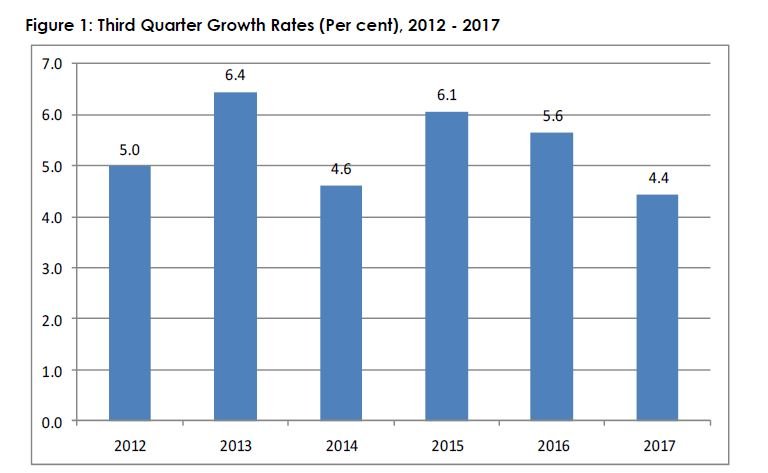Kenya’s economic growth is estimated to have decelerated to 4.4 per cent in the third quarter of 2017 compared to 5.6 per cent in a similar period of 2016. During the quarter, the macroeconomic fundamentals remained largely stable and supportive of growth. However, uncertainty associated with political environment coupled with effects of adverse weather conditions slowed down the performance of the economy. As a result, most sectors of the economy posted slower growths during the quarter under review compared to the same quarter of 2016.
The period under review registered the slowest growth since the fourth quarter of 2013 mainly due to suppressed performance in key sectors of the economy. Financial and insurance activities recorded the largest deceleration from 7.1 per cent in third quarter 2016 to 2.4 per cent in the period under review. Other industries that recorded notable slowdown include; manufacturing; health; accommodation and food services; mining and quarrying and education. On the other hand, accelerated growths were recorded in; professional, administration and support services; public administration; and real estate activities.
Inflation averaged at 7.5 per cent during the third quarter of 2017 compared to an average of 6.3 per cent during a similar quarter in 2016. The rise in inflation was mainly on account of a surge in prices of food and non-alcoholic beverages that started in the second quarter of 2017 and continued into the period under review. The increase in food prices was evidenced by comparably high wholesale prices of key food crops. This was principally attributable to adverse weather conditions that prevailed in the second quarter and for the better part of the third quarter of 2017. Weighted interest rates on commercial banks loans and advances declined to an average of 13.67 per cent in the third quarter of 2017 from 16.54 per cent during a similar quarter in 2016. This was mainly attributable to the capping of interest rates that started in September 2016. The Central Bank Rate (CBR) was maintained at 10.0 per cent throughout the quarter.
The Kenyan Shilling strengthened against the Pound Sterling and the Japanese Yen but weakened against the US Dollar and the Euro. Regionally, the Shilling gained against the Ugandan and Tanzanian currencies but lost against the South Africa Rand during the review quarter. The current account deficit worsened by 28.9 per cent to KSh 145.4 billion in the quarter under review from KSh 112.8 billion in third quarter of 2016. The worsening of the current account was mainly due to a faster growth in imports compared to that of exports that resulted to a deterioration in merchandise trade deficit. In the commodity market, the average Murban Adnoc crude oil prices increased by 10.2 per cent in the period under review to USD 51.05/Barrel from USD 46.32/Barrel recorded in the third quarter of 2016.
Source: Kenya National Bureau of Statistics



